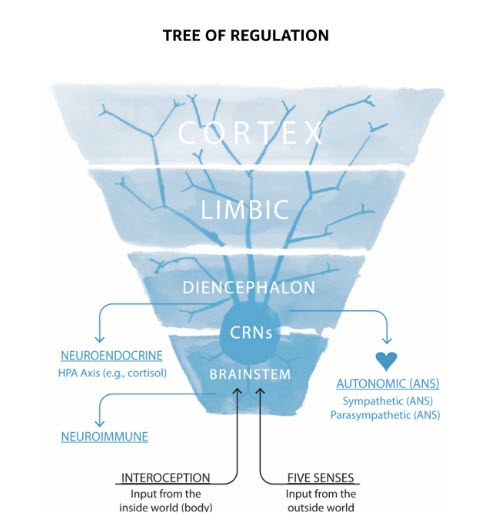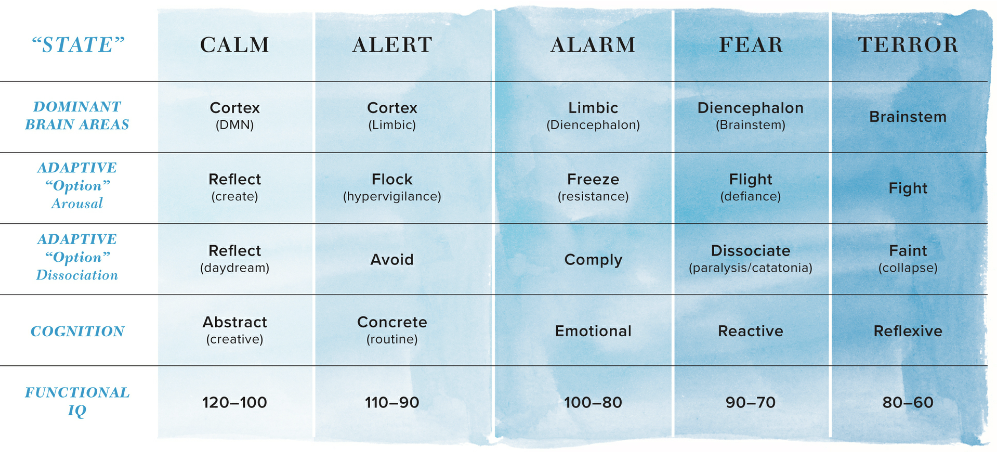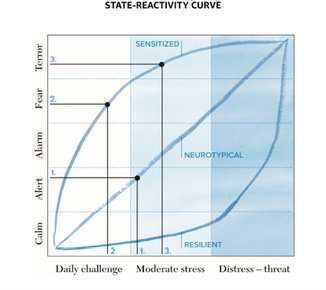This summer, I shifted my life focus to my fitness related projects, so I stopped blogging for a while. But I figured that it’s time to pick it up again.
The book is about trauma, resilience, and healing. It is packed with neuroscientific information and related terminologies. So if you are not a science nerd like me, or have related background, take a second thought before you read it
But if you are, this book is for you. And I highly recommend it for 3 reasons:
- The Q&A-dialogue style makes it more vivid to read but still remain informative.
- The book was published in April 2021 so it’s the state-of-the-art in this field, the materials are also prevalent.
- It’s related to us.
So, without further do, let’s get into the book!
Main idea
Brian structure

Our brain is divided into 4 interconnected parts: brainstem, diencephalon, limbic, and cortex. The structural and functional complexity increases from the bottom to the top – see the figured.
The cortex mediates the most uniquely “human” function like language, cognition.
The brainstem is responsible for our primitive instincts, how we react to stimulus, etc.
In a nutshell, we use our cortex to respond, and our brainstem to react.
The tricky part is, the information first gets processed at the lower parts of our brain, before they have a chance to enter the top, “rational” part of the brain – a bottom-up sequence.
And how these “filters” were set up has something to do with our past. Which we will talk about later.
State-dependent functioning
There are multiple states our brain moves through as it reacts to stress, and the respective approaches it adopts. Each of the state was critical to our survival in the human history.

Our brain stays in the state it deems adequate in terms of the trigger(stressor) it is faced with, until the problem is solved. However, if the same trigger occurs too frequently, for a prolonged period of time, the brain links the adaptive options to its trigger and turn that to a default – without thinking. Again, it’s another advantage in the dangerous environments as it reduces our reaction time to certain threats that habitually happened to us.
But the bad side is, when the environment is no longer threatening, many people are left with a sensitized – overactive stress response system. It’s not an amour that you wear to a war and choose to take it off when the war is over.
It stays with you, but what used to protect you becomes maladaptive.
State-Reactivity Curve
In someone with neurotypical stress-response system (healthy individual), there’s a linear relationship between the degree of stress and the shift in internal state.
If a person has a sensitized stress-response system (top curve) caused by their history of trauma, even the most basic daily challenges will induce the state of fear, and even moderate stress can be met by a terror response.

In someone with neurotypical stress-response system (healthy individual), there’s a linear relationship between the degree of stress and the shift in internal state.
If a person has a sensitized stress-response system (top curve) caused by their history of trauma, even the most basic daily challenges will induce the state of fear, and even moderate stress can be met by a terror response.
The best example would be PTSD – Post-traumatic stress disorder that happened to many ex-soldiers.
Prolonged period of the exposure to the warfare had made their system hypervigilant. Even decades after returning home, a firework sound can be associated to the gun fire and thereby trigger their self-defense response, bringing them back to the war.
It all happen in an instant – The lower part of the brain (brainstem) received the signal and generated the corresponded action, all before the logical part of the brain (cortex), had a chance to participate. What’s worse, the upper part of the brain gets shut down under the state of fear and terror (see the 2nd figure).
Now you understand why What happened to us, literally shapes who we are. People who constantly live (or lived) in the state of imbalance, might not have free access to their upper brain as we think they should have.
Connectedness is the key to change
Developmental traumas are usually the results of unpredicted threats and chaos in the childhood, e.g., abuse, violence. Without positive interaction with people, loving attention from your caregivers, it is almost impossible to step away from dysregulations and imbalance. So the simplest way to regain this balance, is through relationship.
Although it is far more difficult to change human brain in the adulthood than it is in the childhood due to the neuroplasticity of the brain in the developmental stage (The earlier in the age, the more malleable our brain is). With time and patience, under a nurturing, caring environment, we can still heal.
How are these related to us?
You might be thinking to yourself: I grew up in a supportive family; my parents love me; and I’ve never experienced depression, anxiety, or any other stress-related symptom, so I should be good.
Well… yes or no.
We talked a lot about trauma. But the causes for our brain to change are not limited to trauma. Remember we talked about what happened to us shapes who we are?
We are products of how we were raised. We “inherited” our parent’s beliefs, and pass that onto our children. Our first experiences at home created a filter through which all new experiences must pass, before they can enter the cortical part of our brain.
This is really just a fancy way to say: we get our biases from our family.
Implicit Bias vs. Racism
Because implicit bias is involved in the “distorting filters” created in lower parts of the brain, it is usually expressed unintentionally.
On the other hand, racism is embedded in the “rational part” of the brain – it is our belief.
We might be able to answer if we are racist or not. But I don’t think anyone can look into their heart and say they are 100% inclusive to all the other cultures.
The reason it is called bias is because we hardly notice it. It is so deeply ingrained in our system that we don’t even think about the possibility that the opposite could be true.
What happened
When we first meet people of different color in our life, our brain tells us whether these people are good or bad, can be trusted or not, based on what our parents told us. On top of direct education, everything from their reaction when they saw them on TV; the complaints they made on the dining table, all these factors contribute to our first image of these people. If they too have never encountered these people, they got their experience from their parents. And that’s how transgenerational transmission happens. It is not genetically coded, it is learned, absorbed, modified, and taught.
What we can do
When we look at an unfamiliar culture, we are actually looking at it through the lens of our parents. Not until when we can sit down with these people with an acknowledgement that we know nothing about them; interact with them with an open heart, can we overwrite our implicit bias with our own experience.
Final words
It doesn’t matter if you came here to know more about the book; or you were simply drawn to the title but you’d never heard about the book, I hope this article served you in the way you were looking for.
To be honest, the book has so much more interesting findings in the connection between our brain and biological activities. But due to the readability, this article only covers the most important parts.
If you only take one thing from this post today, please remember, what happened to us doesn’t just go away, but with positive relationships, we can make the trauma easier to carry.

